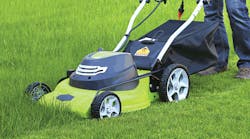It only takes a second to suffer a devastating injury related to yard work. Power equipment such as lawn mowers, weedwackers, edgers and chain saws, as well as human-powered loppers, clippers and hacksaws, can take their toll on fingers and toes.
The routine task of yard work can be extremely dangerous to children, the operator and those nearby if proper safety precautions aren't taken. According to the Consumer Product Safety Commission (CPSC), in 2013 more than 301,000 people were treated for lawn mower-related injuries in a clinic or emergency department, or were admitted to the hospital. More than 10,500 of them are children under age 18, and approximately one-third of lawn mower-related injuries are serious enough to be treated in an emergency department.
"Behind the often pleasant summer task of mowing the yard lurks a serious threat to the health of children, youth and adults. We are hopeful that disseminating information about lawn mower safety may eliminate the thousands of mutilating and at times fatal injuries resulting from the use of both riding and push- or walk-behind lawn mowers," said Allen T. Bishop, MD, professor of orthopedics at the Mayo Clinic and president of the American Society for Reconstructive Microsurgery (ASRM). "If we are to avoid a life-changing event … appropriate prevention is vital."
With the summer mowing season in effect, the American Academy of Orthopaedic Surgeons (AAOS), the American Academy of Pediatrics (AAP) and ASRM are joining forces to educate adults and children about the importance of lawn mower safety.
"Look around any neighborhood with lawns this summer, and unfortunately, you will see children operating or playing around lawn mowers in unsafe ways. For many children and teens, a happy summer day will turn painful," said James M. Perrin, M.D., immediate past president of AAP and professor of Pediatrics, Harvard Medical School; director, Mass General Center for Child and Adolescent Health Policy; and director, Division of General Pediatrics, Massachusetts General Hospital. "It is worth it for parents and kids to take a few minutes to learn and follow a few safety tips before taking on this chore."
Lawn mower injury prevention tips:
- Only use a mower with a control that stops the mower blade from moving if the handle is let go.
- Children should be at least 12 years of age before operating a push lawn mower, and age 16 to operate a driving lawn mower.
- Wear sturdy shoes with good traction.
- Prevent injuries from flying objects, such as stones or toys, by picking up objects from the lawn before mowing begins. Have anyone who uses a mower or is in the vicinity wear polycarbonate protective eyewear at all times.
- Do not pull the mower backward or mow in reverse unless absolutely necessary, and carefully look for children behind you when you mow in reverse.
- Always turn off the mower and wait for the blades to stop completely before removing the grass catcher, unclogging the discharge chute, inspecting or repairing lawn mower equipment or crossing gravel paths, roads, or other areas.
- Use a stick or broom handle (not your hands or feet) to remove debris in lawn mowers.
- Do not allow children to ride as passengers on ride-on mowers and keep children out of the yard while mowing.
- Drive up and down slopes, not across to prevent mower rollover.
- Keep lawn mowers in good working order. When using a lawn mower for the first time in a season, have it serviced to ensure that it is working correctly.
"Lawn mower safety should never take a back seat," said AAOS Immediate Past President Frederick M. Azar, M.D. "No matter how small the task, or how often it's performed, families should always proceed with caution and most importantly seek and share safety tips to help reduce their risk for injury."
Many lawn mower-related injuries require a team of physicians from various specialties to properly repair them and often, patients endure painful reconstructive operations for months or even years to restore function. Some of these procedures can be as complex as moving the big toe to the hand to simulate a thumb.
To read more tips on lawn mower safety, visit OrthoInfo.org.

